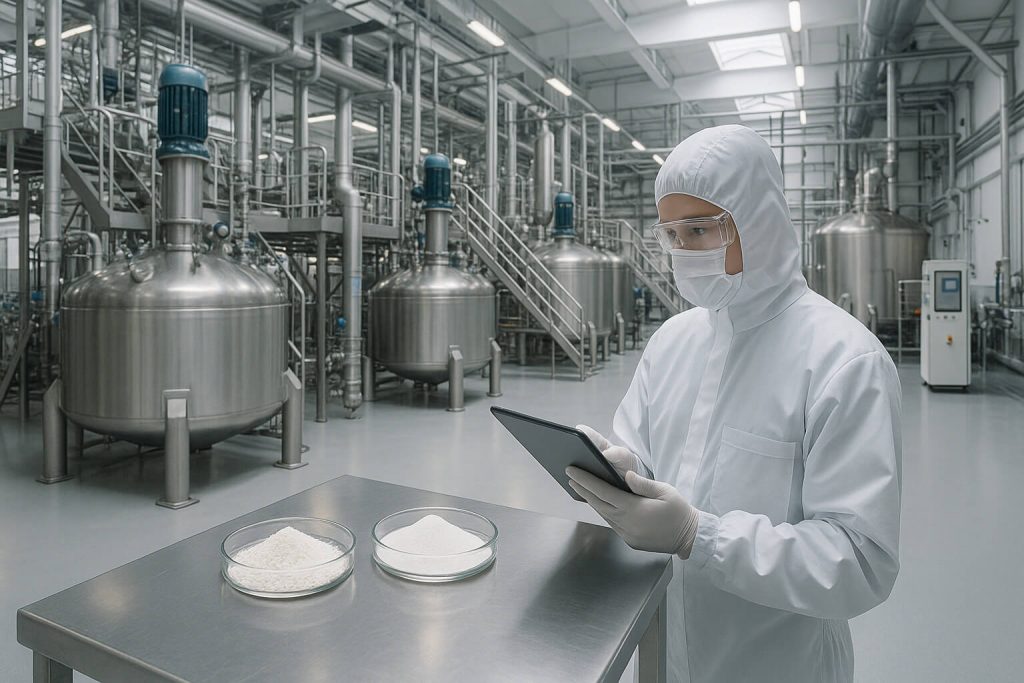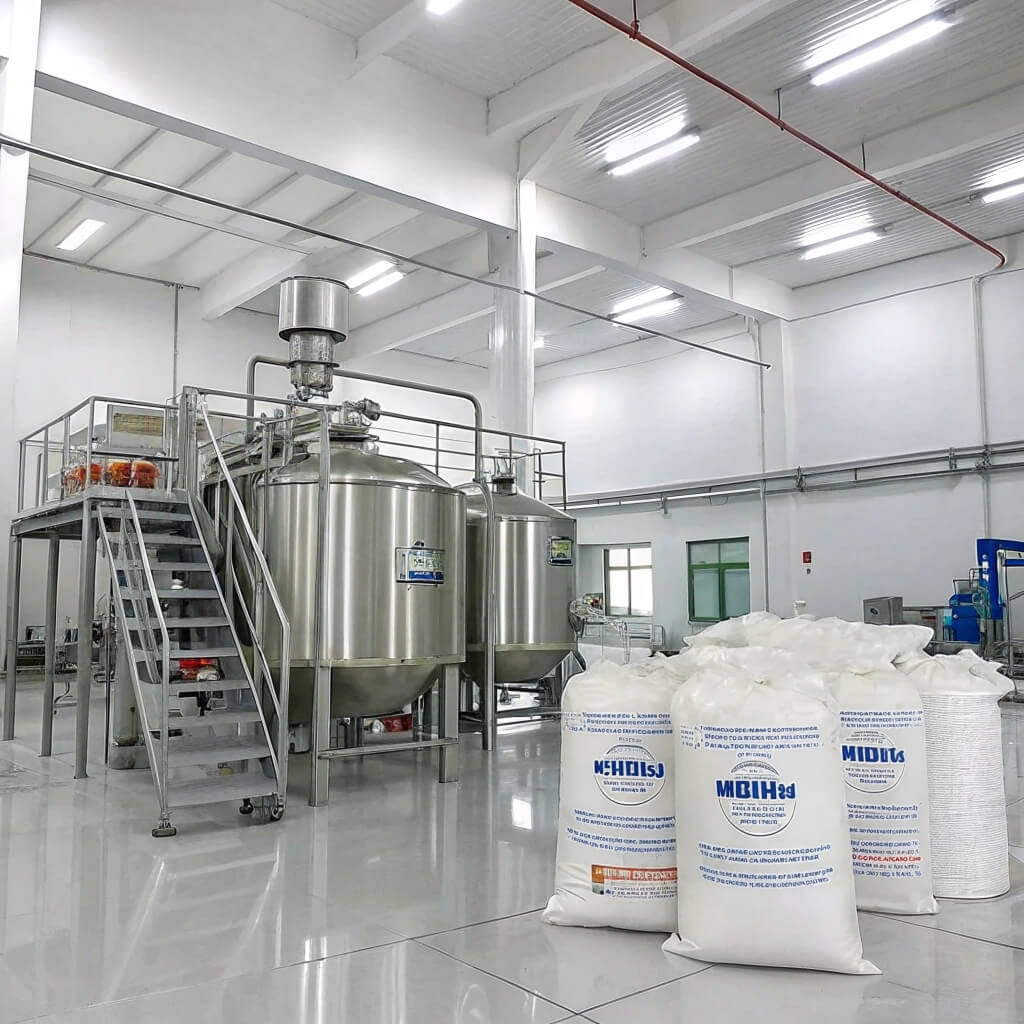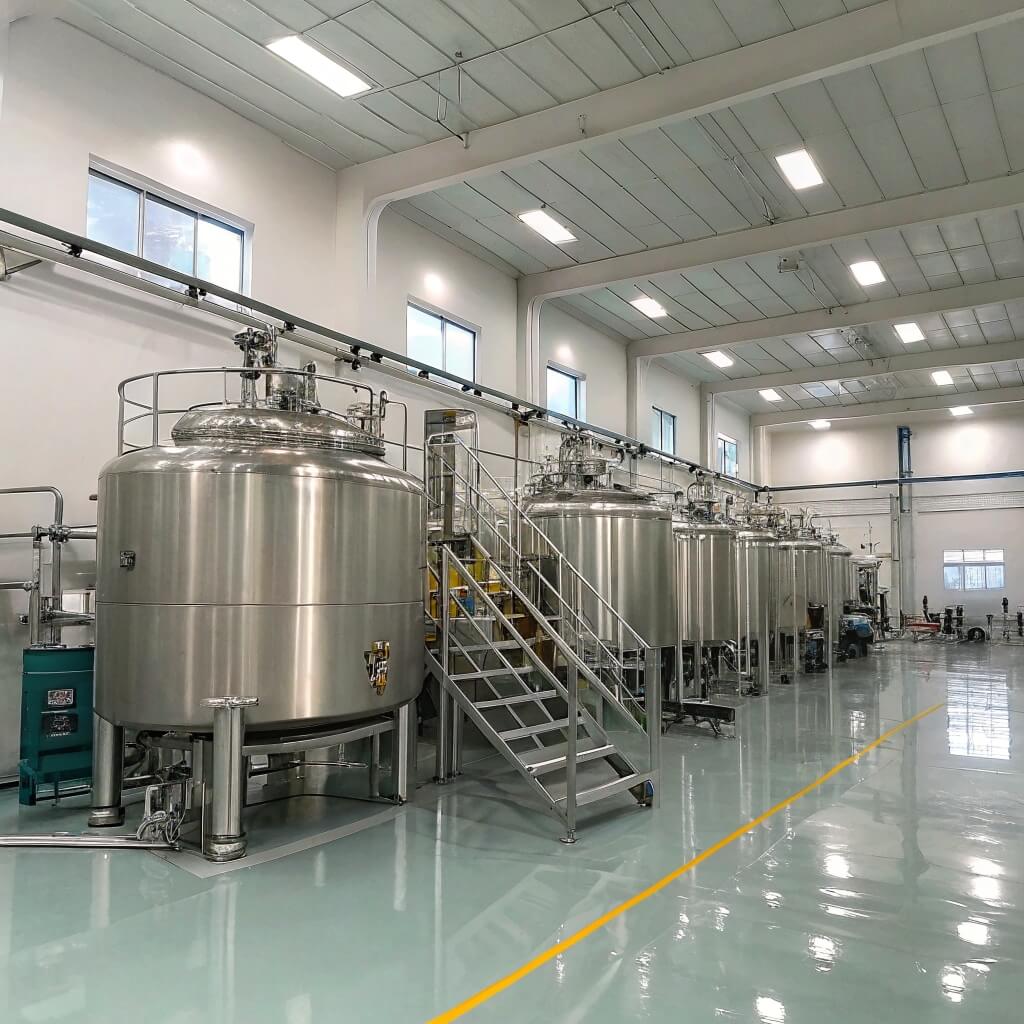Hydroxypropyl Methylcellulose (HPMC) is widely used in the pharmaceutical industry for its versatile properties, especially in controlled-release drug formulations. Among the various grades of HPMC, K4M and K100M stand out for their distinct characteristics and applications. This article will explore the key differences between HPMC K4M and K100M, highlighting their molecular structures, viscosity, and role in different pharmaceutical formulations. By understanding these differences, pharmaceutical manufacturers can make more informed decisions about which grade to use for their specific applications.

1. What is HPMC and Why Is It Important in Pharmaceuticals?
HPMC (Hydroxypropyl Methylcellulose) is a cellulose derivative extensively used in the pharmaceutical industry. It is primarily known for its use as a binder, emulsifier, stabilizer, and controlled-release agent in a variety of drug formulations. But here’s the kicker… its unique ability to modify the viscosity and solubility of formulations makes it an essential ingredient in both immediate and controlled-release drugs.
In pharmaceutical applications, HPMC provides stability to the formulation by ensuring uniformity in the release of active ingredients. It can also improve the mechanical properties of tablets, making them easier to manufacture, store, and consume. Depending on the molecular weight and degree of substitution, HPMC can be tailored for different applications, making it highly versatile.
When it comes to controlled-release formulations, HPMC plays a significant role. It forms a gel matrix around the drug, controlling the release rate based on factors like viscosity and molecular weight. This ability to regulate drug release over time enhances therapeutic outcomes and patient compliance. HPMC’s role as a binder also ensures that active ingredients remain evenly distributed throughout the formulation.
| Solicitud | Papel de HPMC | Beneficio |
|---|---|---|
| Binders | Helps form a cohesive tablet | Ensures uniform distribution of active ingredients |
| Controlled-release systems | Forms gel matrix for drug release | Regulates dissolution rate, improves therapeutic outcomes |
| Emulsions & Suspensions | Stabilizes formulations | Previene la separación, mejora la textura. |
2. What Are the Key Differences Between HPMC K4M and K100M?
HPMC K4M and HPMC K100M are both widely used in pharmaceutical formulations, but they differ in their physical properties, most notably their viscosity. Ready for the good part? These differences influence how each grade behaves in various applications, such as controlled-release formulations, suspensions, and coatings.
HPMC K4M is a low-viscosity grade of HPMC, which means it dissolves quickly in water and forms thinner gels. Its lower viscosity makes it ideal for fast-release tablets, emulsions, and other formulations where rapid dissolution is required. K4M is often used in systems where the active ingredient needs to be released quickly for rapid therapeutic effect.
On the other hand, HPMC K100M is a high-viscosity grade, which forms thicker gels and takes longer to dissolve. This makes it the preferred choice for sustained-release formulations, where a slower release of the active ingredient is necessary for long-term therapeutic action. The higher viscosity also helps improve tablet hardness, making K100M ideal for coatings and capsules that require a stronger matrix to control the release of drugs over extended periods.
| Calificación | Nivel de viscosidad | Tipo de aplicación | Ideal Use |
|---|---|---|---|
| HPMC-K4M | Baja viscosidad | Fast-release tablets, suspensions | Quick dissolution, rapid drug release |
| HPMC K100M | Alta viscosidad | Controlled-release tablets, coatings | Slow release, sustained therapeutic action |
3. How Does HPMC K4M Impact Controlled-Release Formulations?
HPMC K4M is particularly effective in formulations where fast drug release is required. What’s the real story? Despite being a lower-viscosity grade, K4M can still play an essential role in controlled-release formulations, especially those that require rapid dissolution.
In controlled-release formulations, HPMC K4M helps create a gel matrix around the active pharmaceutical ingredient (API). This gel matrix slows down the dissolution of the drug and controls its release over time. However, because of its lower viscosity, the gel matrix formed by K4M dissolves more quickly than that of high-viscosity grades, allowing for faster release in certain applications.
This characteristic makes K4M ideal for formulations such as effervescent tablets or suspensions, where quick dissolution and immediate release of the drug are needed. Additionally, it is often used in combination with other polymers to control the release rate more precisely. For example, in combination with HPMC K100M, it can help provide an initial burst release followed by a sustained release.
| Solicitud | Role of HPMC K4M | Beneficio |
|---|---|---|
| Fast-release formulations | Rapid dissolution, gel formation | Quick therapeutic effect, high bioavailability |
| Suspensiones | Suspends active ingredients | Uniform distribution, smooth texture |
| Effervescent tablets | Helps in the dissolution process | Immediate drug release, patient compliance |
4. How Does HPMC K100M Affect Tablet Formulation and Release Profiles?
HPMC K100M is a high-viscosity grade of HPMC and is commonly used in sustained-release tablet formulations. But here’s the kicker… its ability to form a thick gel matrix significantly impacts the drug release profile, making it ideal for tablets that need to release their active ingredient over a prolonged period.
The higher viscosity of HPMC K100M helps to form a more rigid gel matrix, which dissolves more slowly than that of lower-viscosity grades. This slow dissolution is particularly beneficial for long-acting drugs, where extended release is crucial for maintaining consistent drug levels in the bloodstream. This helps improve patient compliance by reducing the frequency of doses required.
Moreover, HPMC K100M enhances the mechanical strength of the tablet, preventing breakage during handling and improving the tablet’s resistance to environmental factors like humidity. It also helps control the rate at which the drug is released, providing more predictable therapeutic effects.
| Solicitud | Role of HPMC K100M | Beneficio |
|---|---|---|
| Comprimidos de liberación controlada | Forms a thick gel matrix for slow release | Extended therapeutic effects, improved patient compliance |
| Tablets and capsules | Increases tablet strength and durability | Improved handling, reduced breakage |
| Sustained-release systems | Controls dissolution rate | Consistent drug levels over time |
5. Why Should You Choose HPMC K4M for Your Formulations?
HPMC K4M is a versatile choice for various pharmaceutical applications, especially when quick dissolution and a rapid onset of action are required. Ready for the good part? Its lower viscosity makes it ideal for applications where fast drug release is necessary, such as in effervescent tablets, powders, and suspensions.
HPMC K4M is also a cost-effective option for certain formulations. Since it forms thinner gels, it requires smaller amounts of material compared to high-viscosity grades. This makes it an economical choice in large-scale manufacturing, particularly for products like oral suspensions and syrups.
In addition to being cost-effective, HPMC K4M’s low viscosity allows for easier processing, making it a great choice for formulations that need to be mixed or dissolved quickly. It is commonly used in products that require rapid release of the active ingredient, helping achieve immediate therapeutic effects.
| Solicitud | Benefits of HPMC K4M | Ideal Formulations |
|---|---|---|
| Fast-release formulations | Quick dissolution, ease of processing | Effervescent tablets, suspensions |
| Economical formulations | Lower cost, smaller quantity needed | Large-scale manufacturing, oral solutions |
| Immediate drug release | Rapid therapeutic effect | Immediate-release tablets, syrups |
6. What Are the Benefits of HPMC K100M in Sustained-Release and Long-Acting Drugs?
HPMC K100M is the go-to grade for sustained-release drug formulations due to its high viscosity and ability to form a robust gel matrix. This characteristic helps to prolong the release of the active pharmaceutical ingredient, ensuring a steady release over an extended period.
In sustained-release formulations, HPMC K100M helps control the release of the active ingredient by creating a gel that dissolves slowly. This slow dissolution ensures that the drug is released consistently, helping maintain therapeutic drug levels in the body for longer periods. This feature is particularly important for drugs that need to be effective throughout the day, reducing the need for frequent dosing.
HPMC K100M’s thick gel also improves the tablet’s mechanical strength, which is important for ensuring that the tablet doesn’t break during manufacturing or handling. This makes it ideal for controlled-release tablets and capsules that require both structural integrity and prolonged drug release.
| Solicitud | Benefits of HPMC K100M | Ideal Use |
|---|---|---|
| Sustained-release formulations | Prolonged drug release, steady therapeutic effect | Long-acting drugs, controlled-release systems |
| Tablets & capsules | Increased tablet strength | High-strength tablets, slow dissolution drugs |
| Controlled-release systems | Consistent drug release over time | Extended therapeutic action, patient convenience |
7. How Are HPMC K4M and K100M Used in Parenteral and Injectable Formulations?
HPMC is also used in injectable and parenteral formulations, where it serves as a suspending agent or gelling agent. But here’s the kicker… while both HPMC K4M and K100M can be used in parenteral formulations, their differing viscosities impact their performance.
HPMC K4M is typically used in injectable suspensions where rapid dispersion and dissolution of the drug are necessary. Its low viscosity allows for easier injection and quicker dissolution. Conversely, HPMC K100M is used in formulations that require a slower release of the active ingredient, such as long-acting injectable formulations. Its higher viscosity helps create a more stable suspension, allowing the drug to be released over an extended period.
The choice between K4M and K100M depends on the desired release profile and injection characteristics. Both grades can be used to enhance drug stability and ensure uniform distribution of the active ingredients.
| Solicitud | Role of HPMC K4M | Role of HPMC K100M |
|---|---|---|
| Injectable Formulations | Fast dissolution, easy injection | Slow release, stable suspension |
| Long-acting Injectables | Quick therapeutic effect | Prolonged release over time |
| Suspensiones | Uniform distribution of ingredients | Improved stability and release |
8. How Do You Choose Between HPMC K4M and K100M for Specific Pharmaceutical Needs?
Choosing between HPMC K4M and K100M depends on the formulation requirements, particularly the desired viscosity and release profile. Ready for the good part? If your goal is to achieve a rapid release of active ingredients, HPMC K4M is the better choice due to its lower viscosity. It is perfect for fast-release tablets and suspensions that require immediate therapeutic effects.
On the other hand, if you are formulating sustained-release tablets or capsules, HPMC K100M is the ideal option. Its higher viscosity and slower dissolution rate make it perfect for controlling the release of the drug over an extended period, improving bioavailability and reducing dosing frequency.
The choice ultimately depends on the formulation’s needs, the desired release rate, and the cost considerations. Testing different grades of HPMC in small batches can help determine which grade is the most suitable for your product.
| Consideración | HPMC-K4M | HPMC K100M |
|---|---|---|
| Viscosidad | Low viscosity, fast release | High viscosity, slow release |
| Ideal Applications | Fast-release tablets, suspensions | Sustained-release tablets, capsules |
| Costo | More economical | More expensive, but better for extended release |
9. What Are the Challenges in Using HPMC K4M and K100M in Pharmaceutical Products?
While HPMC is a highly versatile ingredient, it does come with some challenges. For HPMC K4M, one of the primary challenges is its relatively low viscosity, which can make it less suitable for formulations that require slow drug release or extended therapeutic action. It may also require additional stabilizers or other polymers to achieve the desired release profile.
HPMC K100M, on the other hand, can sometimes form too thick a gel, which can make it difficult to achieve uniform dissolution rates in certain formulations. Additionally, the higher viscosity may complicate the manufacturing process, particularly in high-speed tablet production lines.
What’s the real story? Both grades of HPMC offer excellent benefits, but they also require careful formulation and testing to ensure they meet the desired performance characteristics for specific applications.
| Desafío | HPMC-K4M | HPMC K100M |
|---|---|---|
| Control de viscosidad | Too low for slow-release systems | Too high for fast dissolution |
| Uniformity in Release | Requires additional stabilizers | May form too thick a gel |
| Manufacturing | Easier to process | Can complicate high-speed production |
10. ¿Cuáles son las tendencias futuras para el uso y la innovación de HPMC?
As the pharmaceutical industry continues to evolve, so does the role of HPMC in drug formulations. Innovations in HPMC technology are enabling the development of more sophisticated controlled-release systems and biocompatible products. Ready for the good part? The future of HPMC in pharmaceuticals looks promising, with increasing demand for environmentally friendly and biodegradable formulations.
With advancements in HPMC modifications, manufacturers can now fine-tune the properties of the polymer to achieve more precise drug release profiles and improved patient outcomes. Additionally, the trend toward personalized medicine is expected to increase the demand for customized HPMC formulations that can cater to specific patient needs.
| Tendencia | Impacto potencial | Aplicaciones futuras |
|---|---|---|
| Personalización | Formulaciones personalizadas para necesidades específicas | Productos farmacéuticos, alimentos y cosméticos |
| Biodegradable Products | Environmentally friendly formulations | Green technologies, eco-friendly drugs |
Sección de preguntas frecuentes
Pregunta 1: What is HPMC and why is it important in pharmaceuticals?
HPMC (Hydroxypropyl Methylcellulose) is a cellulose derivative used in pharmaceuticals as a binder, emulsifier, stabilizer, and controlled-release agent. It plays a critical role in ensuring the effectiveness and stability of drug formulations.
Pregunta 2: How do HPMC K4M and K100M differ from each other?
HPMC K4M and HPMC K100M differ mainly in their viscosity, molecular weight, and solubility. K4M is a lower-viscosity grade, making it suitable for fast-release formulations, while K100M is a higher-viscosity grade used in slow-release and controlled-release formulations.
Pregunta 3: How does HPMC K4M affect controlled-release formulations?
HPMC K4M, with its lower viscosity, is ideal for fast-release formulations. It helps create a gel matrix that dissolves quickly, making it perfect for drugs that require rapid therapeutic effects.
Pregunta 4: What makes HPMC K100M beneficial in sustained-release drugs?
HPMC K100M’s higher viscosity makes it ideal for sustained-release formulations. It helps slow down the dissolution rate of the active ingredient, ensuring prolonged therapeutic action and improved bioavailability.
Pregunta 5: How do you decide whether to use HPMC K4M or K100M in a formulation?
The choice between HPMC K4M and K100M depends on the desired viscosity and drug release profile. K4M is better for fast-release formulations, while K100M is preferred for sustained-release drugs requiring slower dissolution and longer action.




